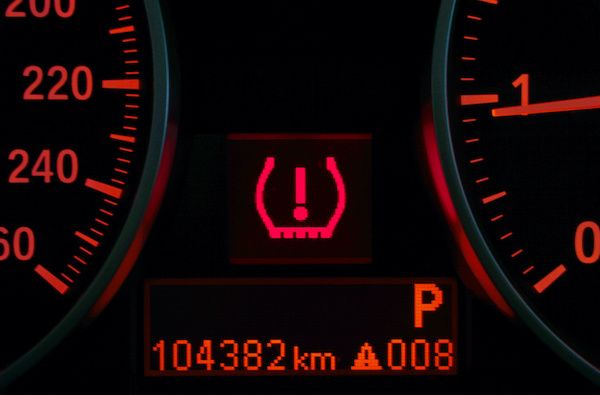


The Tire Pressure Monitoring System (TPMS) is an electronic system designed to monitor the air pressure in a vehicle's tires. It is a crucial safety feature that has been mandated by law to increase vehicle safety and prevent accidents caused by improper tire inflation.
In this article, I'll share my expertise and provide a comprehensive guide on the common causes of bad tire sensor symptoms, how to identify the problem, repair instructions for each cause, and tips on preventing future issues. Buckle up, and let's dive into the world of TPMS!

The TPMS sensors are small, battery-powered devices mounted on each wheel, and they can fail due to various reasons. Here's a table summarizing the most common culprits:
| Common Issues | Description |
|---|---|
| Dead/Low Battery | The sensors are powered by batteries that typically last 5-10 years. As the battery drains, the sensor may fail to transmit data accurately or stop working altogether. |
| Physical Damage | The sensors are exposed to road debris, chemicals, and extreme temperatures, which can cause physical damage to the sensor casing or valve stem over time. |
| Corrosion/Contamination | Road salt, moisture, and other contaminants can corrode the sensor or valve stem, leading to malfunctions. |
| Wiring/Electrical Issues | Problems with the TPMS wiring harness, control module, or other electrical components can prevent the sensors from communicating properly with the system. |
Let's dive deeper into each of these causes:
Dead/Low Battery:The TPMS sensors are battery-powered, and as the battery drains, it can cause various issues. The sensor may start transmitting inaccurate data, or it may stop transmitting altogether, leading to a warning light on your dashboard. The battery life of these sensors is typically around 5-10 years, but it can vary depending on factors such as temperature, usage, and the quality of the sensor itself.
Physical Damage:The sensors are mounted on the wheel, which means they're exposed to all sorts of hazards on the road. Road debris, potholes, and even curb strikes can cause physical damage to the sensor casing or valve stem, leading to failure. This type of damage can range from minor cracks or dents to complete destruction of the sensor, rendering it unusable.
Corrosion/Contamination:Road salt, moisture, and other contaminants can wreak havoc on the TPMS sensors. Over time, these elements can corrode the sensor or valve stem, causing it to malfunction or stop working entirely. Corrosion can also lead to electrical issues, further compounding the problem.
Wiring/Electrical Issues:The TPMS system relies on a complex network of wiring, connectors, and a control module to function properly. If there are any issues with the wiring harness, damaged connectors, or problems with the control module itself, it can prevent the sensors from communicating with the system, leading to various warning lights and error codes. Electrical issues can be particularly challenging to diagnose and repair, as they can be intermittent or caused by multiple factors.
Now that you understand the common causes of bad tire sensor symptoms, let's discuss how to diagnose the issue.
Visual Inspection:Start by visually inspecting each tire's valve stem and sensor for any physical damage, corrosion, or missing components. Look for cracks, dents, or any signs of wear and tear. This can often provide valuable clues about the nature of the problem.
TPMS Diagnostic Tool:Use a dedicated TPMS diagnostic tool to scan and test each sensor individually. These tools can read sensor data like ID, pressure, temperature, and battery status, giving you a clear picture of which sensor might be causing the issue.
Here's an example of the information a TPMS diagnostic tool might display:
| Sensor ID | Pressure (PSI) | Temperature (°F) | Battery Status |
|---|---|---|---|
| 12345 | 32 | 78 | Good |
| 67890 | 28 | 80 | Low |
| 24680 | No Data | No Data | Dead |
| 13579 | 35 | 75 | Good |
In this example, the sensor with ID 24680 is likely dead or not transmitting any data, while the sensor with ID 67890 has a low battery.
Scan for Trouble Codes:Connect a professional-grade scan tool to your vehicle's diagnostic port and check for any stored trouble codes related to the TPMS system. These codes can provide valuable insights into the nature of the problem.
Common TPMS trouble codes include:
C1234 - Left Front Sensor Malfunction
C1235 - Right Front Sensor Malfunction
C1236 - Left Rear Sensor Malfunction
C1237 - Right Rear Sensor Malfunction
C1238 - TPMS Control Module Malfunction
Inflate Tires and Observe:Inflate all tires to the recommended pressure and observe if the TPMS warning light turns off. If the light remains on, it's a strong indication of a sensor issue.
Here are some common scenarios that can help you pinpoint the specific failure:
Flashing TPMS Warning Light: A flashing TPMS warning light typically indicates a sensor malfunction or a dead battery in one of the sensors.
No Sensor Data: If your TPMS diagnostic tool displays a "No Sensor Detected" message or shows no data for a particular sensor, it means that sensor is either dead or not transmitting any information.
Incorrect Pressure Readings: If the pressure readings from the TPMS system don't match the readings from a manual tire pressure gauge, it's a clear sign that the sensor is faulty and needs to be replaced.
Trouble Codes: Certain trouble codes related to specific sensors can pinpoint the exact failed unit, making it easier to diagnose and repair the issue.
Once you've identified the cause of the bad tire sensor symptoms, it's time to roll up your sleeves and get to work.
If the issue is a dead battery in one of the TPMS sensors, the entire sensor needs to be replaced, as the battery is non-replaceable. Here's the process:
Follow the proper procedure to demount the tire and remove the old sensor.
Install the new TPMS sensor, ensuring it's properly seated and tightened to the correct torque specifications.
Reprogram or relearn the new sensor to sync with your vehicle's TPMS system.
In cases of physical damage or corrosion, you'll need to replace the entire TPMS sensor unit. Here are the steps:
If the valve stem is damaged, replace the entire TPMS sensor unit.
Clean any corrosion or contamination from the sensor mounting area using a wire brush.
Install the new sensor, ensuring proper seating and torque specifications.
Reprogram the new sensor as needed, following the manufacturer's instructions.
If the problem lies with the TPMS wiring or electrical components, you'll need to diagnose and repair any wiring faults, damaged connectors, or control module issues. Here's what you need to do:
Diagnose and repair any wiring faults, damaged connectors, or control module issues.
Ensure proper power and ground connections for the TPMS system.
After repairs, follow the relearn procedure to resynchronize the sensors with the system.
Always use the correct sensor type specified for your vehicle make and model.
Take precautions when demounting tires to avoid damaging the new sensors.
Consult vehicle-specific service information for relearn procedures and torque specifications.
Replace valve stem cores/caps with high-quality stainless steel components to prevent future corrosion.
While replacing faulty TPMS sensors is necessary, it's also essential to take preventive measures to avoid future issues.

Inspect tires, valve stems, and sensors during routine tire rotations or oil changes.
Replace TPMS sensors every 5-7 years as preventive maintenance, even if they're not faulty.
Here's a table to help you keep track of when to replace your TPMS sensors:
| Vehicle Year | Recommended Replacement Year |
|---|---|
| 2018 | 2023 - 2025 |
| 2019 | 2024 - 2026 |
| 2020 | 2025 - 2027 |
| 2021 | 2026 - 2028 |
| 2022 | 2027 - 2029 |
Maintain recommended tire pressures and inspect tires regularly.
Avoid using aerosol tire sealants, as they can clog and damage TPMS sensors.
Have tires serviced by qualified professionals who follow TPMS relearn procedures.
The cost of replacing TPMS sensors can vary depending on several factors. Here's a general breakdown:
A single TPMS sensor can cost anywhere from $50 to $100, plus $60 to $70 for labor if done by a professional mechanic.
Replacing all four sensors can cost between $200 and $800, depending on the vehicle make and model, as well as the type of sensors used (OEM or aftermarket).
Additional costs may include taxes, programming fees, and any related repairs needed.
Here's a table to give you an idea of the potential costs:
| Repair | Parts Cost | Labor Cost | Total Cost |
|---|---|---|---|
| Single Sensor Replacement | $50 - $100 | $60 - $70 | $110 - $170 |
| All Four Sensors Replacement (OEM) | $200 - $400 | $60 - $70 | $260 - $470 |
| All Four Sensors Replacement (Aftermarket) | $100 - $200 | $60 - $70 | $160 - $270 |
If you're comfortable working on your vehicle, you can save on labor costs by replacing the sensors yourself. However, you'll need to purchase the correct sensors, tools (e.g., TPMS tool, torque wrench), and follow the proper procedures. Improper installation can lead to additional repair costs down the line.
Bad tire sensor symptoms can be frustrating, but with the right knowledge and tools, they're relatively straightforward to diagnose and repair. As a mechanic, I've seen firsthand how neglecting these issues can lead to more significant problems down the road.
By understanding the common causes, learning how to identify the problem, and following the proper repair procedures, you can keep your TPMS system in top shape and ensure your tires are always at the correct pressure for optimal safety and performance.
Remember, regular maintenance and proper usage are key to preventing future issues with your TPMS sensors. Don't hesitate to seek professional help if you're unsure about any aspect of the repair process. Your safety on the road is worth the investment.
The article does not provide specific details on the reprogramming or relearning process. This information could be helpful for readers who plan to replace the sensors themselves.
The article does not mention the potential impact of faulty TPMS sensors on fuel efficiency or overall vehicle performance, which could be a concern for readers.
The article lacks visuals or diagrams that could help readers better understand the sensor locations, repair steps, or other relevant information.
Providing guidance on identifying OEM vs. aftermarket sensors could be useful for readers, as the cost and quality may vary.
Clarifying the urgency or potential risks of driving with a bad sensor could help readers prioritize the repair.
Including information on environmental factors that may impact sensor durability could be valuable for readers in different regions.
Mentioning any specialized tools required for the repair could help readers prepare or decide whether to seek professional assistance.
Clarifying if sensors can be replaced individually or if a complete set is recommended could help readers plan and budget accordingly.
Providing safety guidelines or precautions could be helpful for readers who plan to replace the sensors themselves.
Discussing the potential impact of improper tire maintenance on sensor lifespan could encourage readers to follow best practices.

Sarah isn't your average gearhead. With a double major in Mechanical Engineering and Automotive Technology, she dived straight into the world of car repair. After 15 years of turning wrenches at dealerships and independent shops, Sarah joined MICDOT to share her expertise and passion for making cars run like new. Her in-depth knowledge and knack for explaining complex issues in simple terms make her a valuable asset to our team.













